Suppose that x GE 1 Prove that 1 x2 GE 1 2x Prove that 1
Solution
(i)
we are given that x>= -1
and (1 + x)^2 will always be >= 0
and (1 + 2x) >= -1
now we can see that at x = -1
(1 + x)^2 = 0 and (1 + 2x) = -1
and we know that 0 > -1
now at x = 0
(1 + x)^2 = 1 and (1 + 2x) = 1
and we know that 1 = 1
and for all other values of x > 0
(1+x)^2 > (1 + 2x)
hence proved that
for x>=-1
(1+x)^2 >= (1 + 2x)
(ii) for x >= -1
when x = -1
(1 + x)^3 = 0 and (1+3x) = -2
and we know that 0 > -1
when x = 0
(1+x)^3 = 1 and (1+3x) = 1
we know that 1 = 1
and for all other values of x > 0
(1+x)^3 > (1+3x)
hence proved that for x>=-1
(1+x)^3 >= (1+3x)
now if we look at the above two inequalities we could see that
the exponent on the left hand side is the same as the coefficient of x on the right hand side
for exmple in (1+x)^3 >= (1+3x)
the exponent on the left is 3 and the coefficient of x on the right is 3
so in general we could write the inequality as :
(1 + x)^n >= (1 + nx) when x >=-1 and n E N
N stands for natural numbers N = 1 , 2, 3 ,4.......N


 Homework Sourse
Homework Sourse